What to do if the red lion Measuring Instruments display is jittery?
- MMark HuertaAug 16, 2025
If the display is jittery, increase Module 1 filtering, rounding, and input range. Also, verify that the wiring follows EMC installation guidelines.
What to do if the red lion Measuring Instruments display is jittery?
If the display is jittery, increase Module 1 filtering, rounding, and input range. Also, verify that the wiring follows EMC installation guidelines.
What to do if the red lion Measuring Instruments shows incorrect input display value?
If the input display value is incorrect, check the following: * Module 1 programming * Input Range Jumper position * Input connections * Input signal level * Module 4 Display Offset is zero Press DSP for Input Display. If the problem persists, perform Module 9 Calibration.
What does OLOL mean on my red lion Measuring Instruments display?
If “OLOL” is displayed (SIGNAL HIGH), check Module 1 programming, the Input Range Jumper position, input connections, and the input signal level.
What does ULUL mean on my red lion Measuring Instruments display?
If “ULUL” is displayed (SIGNAL LOW), check Module 1 programming, the Input Range Jumper position, input connections, and the input signal level.
How to fix a program locked-out on red lion Measuring Instruments?
If the program is locked-out, check the active (lock-out) user input and enter the security code when requested.
What to do if modules or parameters are not accessible on red lion Measuring Instruments?
If modules or parameters are not accessible, check the corresponding plug-in card installation.
What does error code Err 1-4 mean on red lion Measuring Instruments?
If you see error code Err 1-4, press the Reset KEY. If that doesn't clear the error, contact factory.
How to fix max, min, tot locked-out on red lion Measuring Instruments?
If MAX, MIN, or TOT is locked-out, check Module 3 programming.
How to disable zero chop feature on red lion Measuring Instruments?
To disable the zero chop feature, program Module 4 as Hi-t: 0.0 LO-t: 3271.1.
How to troubleshoot no display on a red lion Measuring Instruments?
To troubleshoot a 'no display' issue, check the power level and power connections.
Lists MPAX modules for LPAX5 analog displays, detailing input types and power options.
Lists MPAX modules for LPAX6 digital displays, including plug-in card compatibility.
Lists MPAX modules for LPAXDA dual analog units, covering DC inputs.
Covers various input signal types and their capabilities, including common mode rejection.
Provides essential safety regulations and instructions for safe installation and operation.
Explains how to add up to three optional plug-in cards to PAX/MPAX meters.
Provides instructions for mounting the meter into an enclosed panel for NEMA 4/IP65 compliance.
Explains how to select the proper input range using jumpers to avoid signal overload.
Illustrates jumper settings for PAXD model's Input Range, Excitation Output, and User Input Logic.
Provides general guidelines for electrical connections, terminal blocks, and wire stripping.
Offers guidelines for minimizing electromagnetic interference (EMI) during installation.
Shows AC and DC power wiring diagrams for the meter terminals.
Illustrates wiring for various PAXD input types: voltage, current, resistance, potentiometer.
Shows wiring diagrams for PAXP voltage, current, and 3-wire transmitter inputs.
Details Full Programming and Quick Programming modes, their differences, and when to use them.
Provides recommendations for organizing programming tasks and recording settings.
Explains how to restore factory settings and where to find them.
Outlines the process for entering programming mode, selecting modules, and setting parameters.
Shows the parameter menu structure for PAXH input signal parameters.
Shows the parameter menu structure for PAXT input signal parameters, including custom scaling.
Details input range selection for PAXS meters, emphasizing signal overload prevention.
Details input range selection for PAXD meters, emphasizing signal overload prevention.
Lists input types for PAXT, including thermocouple and RTD selections.
Details access levels for Full and Quick Programming Modes based on user input and security code.
Resets all user settings to factory defaults using a specific code.
Provides general guidance on calibration procedures and when it's required.
Step-by-step calibration procedure for PAXP meters for various ranges.
Step-by-step calibration procedure for PAXD meters for various ranges.
Step-by-step calibration procedure for PAXH meters using DC signals for AC ranges.
Lists checks for when the meter has no display, including power and connections.
Provides steps to unlock programming mode, including security code entry.
Troubleshooting steps for when Max, Min, or Totalizer displays are locked out.
Guidance for correcting inaccurate input display values, checking programming and calibration.
Explains the 'OLOL' message indicating a signal is too high and troubleshooting steps.
Explains the 'ULUL' message indicating a signal is too low and troubleshooting steps.
Troubleshooting steps for jittery displays, including filtering and rounding.
Lists MPAX modules for LPAX5 analog displays, detailing input types and power options.
Lists MPAX modules for LPAX6 digital displays, including plug-in card compatibility.
Lists MPAX modules for LPAXDA dual analog units, covering DC inputs.
Covers various input signal types and their capabilities, including common mode rejection.
Provides essential safety regulations and instructions for safe installation and operation.
Explains how to add up to three optional plug-in cards to PAX/MPAX meters.
Provides instructions for mounting the meter into an enclosed panel for NEMA 4/IP65 compliance.
Explains how to select the proper input range using jumpers to avoid signal overload.
Illustrates jumper settings for PAXD model's Input Range, Excitation Output, and User Input Logic.
Provides general guidelines for electrical connections, terminal blocks, and wire stripping.
Offers guidelines for minimizing electromagnetic interference (EMI) during installation.
Shows AC and DC power wiring diagrams for the meter terminals.
Illustrates wiring for various PAXD input types: voltage, current, resistance, potentiometer.
Shows wiring diagrams for PAXP voltage, current, and 3-wire transmitter inputs.
Details Full Programming and Quick Programming modes, their differences, and when to use them.
Provides recommendations for organizing programming tasks and recording settings.
Explains how to restore factory settings and where to find them.
Outlines the process for entering programming mode, selecting modules, and setting parameters.
Shows the parameter menu structure for PAXH input signal parameters.
Shows the parameter menu structure for PAXT input signal parameters, including custom scaling.
Details input range selection for PAXS meters, emphasizing signal overload prevention.
Details input range selection for PAXD meters, emphasizing signal overload prevention.
Lists input types for PAXT, including thermocouple and RTD selections.
Details access levels for Full and Quick Programming Modes based on user input and security code.
Resets all user settings to factory defaults using a specific code.
Provides general guidance on calibration procedures and when it's required.
Step-by-step calibration procedure for PAXP meters for various ranges.
Step-by-step calibration procedure for PAXD meters for various ranges.
Step-by-step calibration procedure for PAXH meters using DC signals for AC ranges.
Lists checks for when the meter has no display, including power and connections.
Provides steps to unlock programming mode, including security code entry.
Troubleshooting steps for when Max, Min, or Totalizer displays are locked out.
Guidance for correcting inaccurate input display values, checking programming and calibration.
Explains the 'OLOL' message indicating a signal is too high and troubleshooting steps.
Explains the 'ULUL' message indicating a signal is too low and troubleshooting steps.
Troubleshooting steps for jittery displays, including filtering and rounding.
| Display Type | LCD |
|---|---|
| Mounting | Panel Mount |
| Input Types | Thermocouple, RTD, Frequency |
| Communication | RS-485 |
| Environmental Rating | NEMA 4X |
| Dimensions | 96 x 48 mm (3.78 x 1.89 inches) |
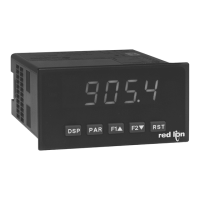

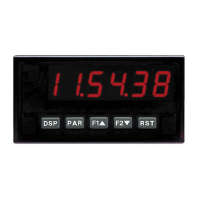
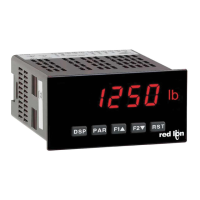
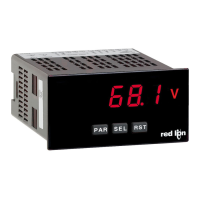
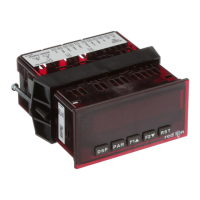
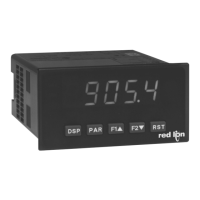
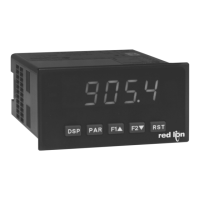
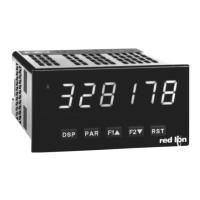



